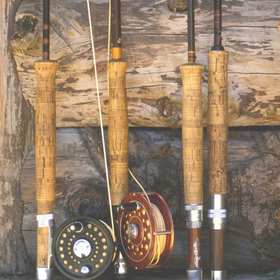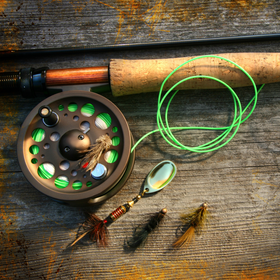In another article titled Mayfly Nymph, we covered the basics of the nymph stage of the mayfly. We now will cover the adult phases of this crucially important insect. Although most of its life is indeed spent as a nymph, dwelling at the river or lake bottom, it is the adult that has truly captured the fancy of fly fisherman. It’s the adults that were given the colorful names that we listed in the Mayfly Nymph article. And it is the adult that fly fishing elitists consider the only form worthy of imitation.
 - Hendrickson Mayfly Dun (photo: www.troutnut.com)
- Hendrickson Mayfly Dun (photo: www.troutnut.com)After spending a year or so as a nymph, the mayfly emerges to the surface. On the way, it shucks its outer skin, and pumps fluids into it’s wings. This emerging stage has caught on in popularity in the fly fishing world, as the mayfly emerger is extremely vulnerable. Many mayfly species are clumsy swimmers at best, and combine that with shucking their outer nymph skin, they become a flailing treat for the waiting trout.
Upon emerging they need to dry their wings. There they sit on top of the water, with their sailboat wings upright. The mayfly cannot fold their wings down, which also lend to their visibility for the waiting trout. At this stage they are called ‘duns’. Usually duller in color, they can spend anywhere from a few seconds to a few minutes on top of the water. This is the stage where fly fisherman typically use dry flies to imitate the mayfly. Although each individual insect is only in this stage for a short time, mayflies can emerge by the thousands with the hatches lasting for several hours at a time. It is a joy of fly anglers around the world to witness and participate in one of these hatches.
 - Blue Wing Olive Dun (photo: www.troutnut.com)
- Blue Wing Olive Dun (photo: www.troutnut.com)After drying their wings, mayflies fly to a nearby shrub, tree or bush (or the wall of the toilet at the boat launch). Not being very good fliers, their two or three tails are thought to aid in stabilizing them. Although to our eyes ,they appear like a lot for them to maneuver and carry. Here the duns molt into a second adult phase called spinners. Their second pair of wings now fully developed, they are also sexually mature. After a few hours or up to a day, they usually, though not always, return to over the water, where they mate. The males will swarm, and the females fly into the swarm and choose their mate.
 - This Callibaetis Spinner is nearing the end of it's life cycle. It is ready to lay open it's wings and perish
- This Callibaetis Spinner is nearing the end of it's life cycle. It is ready to lay open it's wings and perishAfter mating the females lay their eggs, and both male and female die. Trout also key on this stage as the ‘spent wing’ spinners give the mayfly one last chance to ‘offer’ itself to the awaiting trout. From our point of view it is hard to deny that the mayfly’s life is nothing but a gift to the wild trout. And the recognition of this fact centuries ago was a gift of one careful observer to the generations of fly fisher’s that have followed.




